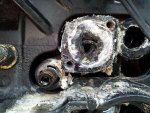mr300z87
Senior Chief Petty Officer
- Joined
- Sep 15, 2010
- Messages
- 694
After a month long preparation which included upgrading my steering, upgrading to dry joint exhaust, replacing circulation pump, impeller on raw pump (bravo drive external belt driven pump) and a fresh coat of bottom paint my boat is in the water and running great. We have been using it a couple time a week since the holiday weekend. The engine is a 5.7L (see serial# in signature file) I was wondering what is normal operating temperature. I do not believe there is a problem since she has never over heated. My operating temps vary with rpm, at no wake speed 1000 - 1300 the gauge reads about 140 but at cruise speeds 2800-3000 the gauge reads about 165. I do not usually run it much higher than 3000 rpms but when I have for short bursts is gets even closer to the 175 degree hash mark on the gauge. Once back down to idle and or just above the temp drops back down to 140 ish which is just above the half way mark between the 100 degree and 175 degree marks. I have never seen it go above 175 dregees. My engine is raw water cooled, has the cooling hoses to the bottom of the manifold and also to the elbow and I used the pricey merc gasket with the restrictor one side of the gasket (dry joint exhaust). All parts used were mercruiser parts except for the circulation pump. I understand that gauges can be slightly inaccurate and I have not used an infrared gun so I do not know what the true engine temp. However I can say that with the new exhaust manifolds and elbows the temp have been much more consistent. One last thing on the last two outings the air temps have been in the mid 90s with high humidity, and bay water temps are approaching 75 degrees. As always any info is greatly appreciated. Mike





















